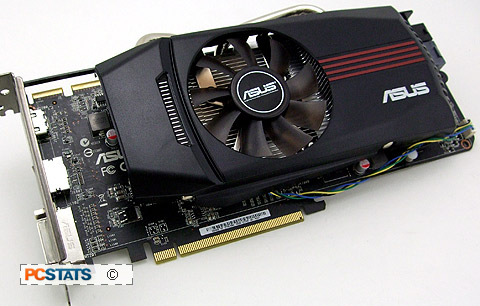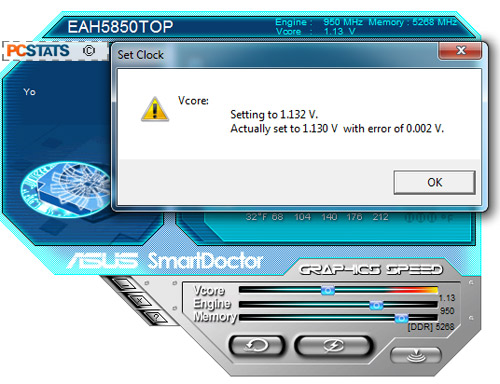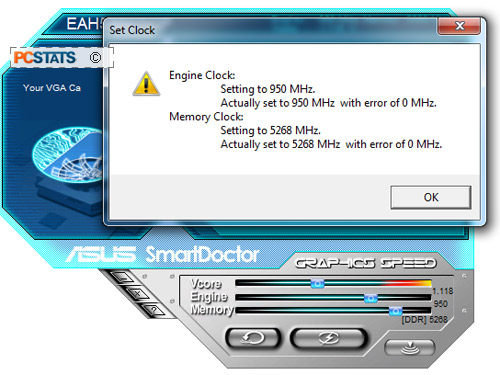 |
| Overclocking Results: |
|
|
The ASUS EAH5850 DirectCU TOP videocard ships
pre-overclocked, but if you want things even quicker it's not very difficult to
push the speeds up by a fair margin. By default the HD 5850 GPU has been
raised from the stock 725MHz to 765MHz and the memory from 1000MHz up to 1125MHz
(4500MHz GDDR5). That's a nice performance edge, but given that ASUS have
selected the GPU and memory for this particular TOP series,
specifically for overclockability, you can be assured that it will handle being
overclocked much further.
PCSTATS is going to see just how much extra speed these cherry-picked parts
can net you.
 Using ASUS' included SmartDoctor software, the GPU's
core engine clock was pushed from its default 765MHz clock up to 850MHz. After
that the clockspeed was increased in 15MHz increments, passing easily through
895MHz and then up to 940MHz. Finally at 965MHz the system would hang and crash.
Max overclock for the GPU alone was 955MHz - check.
Using ASUS' included SmartDoctor software, the GPU's
core engine clock was pushed from its default 765MHz clock up to 850MHz. After
that the clockspeed was increased in 15MHz increments, passing easily through
895MHz and then up to 940MHz. Finally at 965MHz the system would hang and crash.
Max overclock for the GPU alone was 955MHz - check.
Turning to the memory (GPU back at default speeds), the
1GB of GDDR5 was pushed from it's factory overclocked state of 1125MHz up to
1225MHz, and then it too was raised in 15MHz increments. The EAH5850 DirectCU
TOP videocard played well enough, so we were able to overclock the Samsung
GDDR5 from 1270MHz up to 1325MHz without breaking a sweat, before finally
capping out at 1355MHz with a crash. Max overclock for the memory alone
was 1345MHz - check.

Getting both the core clock and the memory stable at top
speeds proved to be a little trickier, with graphical corruption occuring if
both were set to their max speeds. It was time to adjust the voltages and try a
few different speed settings.

By
raising the Vcore from 1.118V to 1.1136V and backing off a little on the speed,
it was possible to get the EAH5850 DirectCU TOP videocard stable at
945MHz core clock speed with 1315MHz (5260Mhz) memory.
Altogether PCSTATS was able to overclock ASUS' EAH5850 DirectCU TOP GPU and
memory speeds by about 25% over the speeds of a generic Radeon HD 5850, not bad
at all!
While these maximum overclocked speeds are good to know,
you should keep in mind that with this generation of GPU from ATI, you DON'T
actually want to run things this fast, or performance in benchmarks and games
may be degraded. The memory in particular seems to give the best benchmark
results at speeds of under 1300MHz, beyond that benchmark scores can actually
begin to fall off quite significantly. PCSTATS ran a tone of 3DMark benchmarks
and the results were all over the place... the best advice I can give you is
overclock at the default settings, then modestly overclock the videocard and
re-benchmark it. Finally, push things as far as they'll go, benchmark it and
compare those results to the first two data points. There will a point between a
modest overclock and maximum overclock that gets you the best results for the
clock, and beyond that point benchmarks will start to run slower. Only trial and
error will show you what's the best overclocked setting. Unfortunately this takes
some fun out of the overclocking game. Oh well.
Prelude to Benchmarks
The
details of how the ASUS EAH5850 DirectCU TOP videocard was configured for
benchmarking; the specific hardware, software drivers, operating system and
benchmark versions are indicated below. All benchmarks for the videocard were
run in Windows 7 Ultimate, the reference video cards were tested in both Windows
XP and Vista for the DX10 benchmarks. PCSTATS is in the process of making the
transition to a Windows 7 and Intel CPU test platform, so keep this in mind as
you scan the benchmark results. In the second column are the general specs this
videocard is compared against.
 |
| PCSTATS Test System Configurations |
|
|
Benchmark results are
organized by GPU manufacturer first (AMD/ATI or nVidia), then by GPU generation,
and then by GPU class (high end, mainstream, value). This approach provides a
clearer view of how performance can differ from generation to generation, and
class to previous generation. The product being tested is marked with the red
colour bar.
